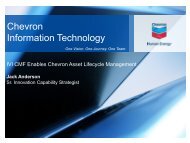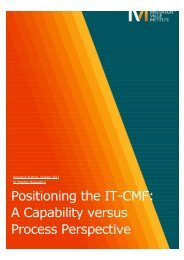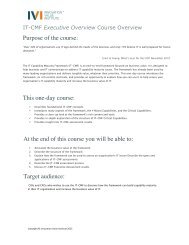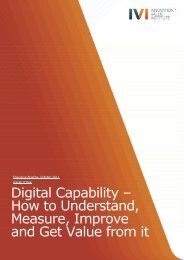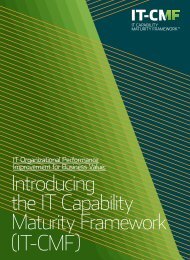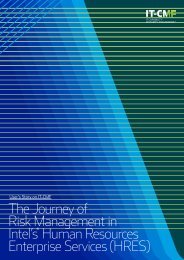IVI - Innovation Value Institute - National University of Ireland ...
IVI - Innovation Value Institute - National University of Ireland ...
IVI - Innovation Value Institute - National University of Ireland ...
You also want an ePaper? Increase the reach of your titles
YUMPU automatically turns print PDFs into web optimized ePapers that Google loves.
Figure 1<br />
Learning Curves<br />
Know-How<br />
<strong>Value</strong> <strong>of</strong> Knowledge and Know-How<br />
Many efforts have been made to determine the<br />
value <strong>of</strong> knowledge. Such efforts range from<br />
estimating the contribution <strong>of</strong> intellectual capital<br />
‘intangible assets’ as part <strong>of</strong> a company’s book<br />
value (examples: Sveiby [2], Edvinsson [3], and<br />
Stewart [4]) to the ‘Learning and Growth’ metrics<br />
<strong>of</strong> Kaplan & Norton’s Balanced Scorecard [5].<br />
Even though a generally recognised quantitative<br />
description remains elusive, most people<br />
believe that knowledge has business value. For<br />
this discussion, let’s use a simple metric for<br />
knowledge: revenue per employee (total income<br />
divided by total number <strong>of</strong> employees).<br />
Know-how grows over the course <strong>of</strong> a career. There<br />
are a few common milestones along this journey<br />
such as novice, competent performer, expert,<br />
and master. Think about the learning journey <strong>of</strong><br />
new hires. They enter your company with a good<br />
formal education and are up-to-date on theories<br />
and principles. It normally takes them a year or<br />
two <strong>of</strong> training to understand company processes<br />
for getting work done and to become productive<br />
novices. The revenue breakeven point (i.e., the<br />
length <strong>of</strong> time it takes a new employee to begin<br />
generating a positive cash flow after covering<br />
salary and training costs) will depend on how fast<br />
they learn and the nature <strong>of</strong> their job assignments.<br />
Positive cash flow may not occur until several years<br />
after hire. Perhaps an additional three-to-four<br />
years <strong>of</strong> increasingly challenging job experiences<br />
will make them competent performers who are<br />
comfortable with company processes and able to<br />
deliver quality work with a minimum <strong>of</strong> supervision.<br />
Master<br />
Expert<br />
Competent<br />
Performer<br />
Positive<br />
Accelerated<br />
Novice Cash Flow<br />
Normal<br />
Time (Years)<br />
A commonly accepted benchmark is that it takes<br />
an employee seven-to-ten years <strong>of</strong> concentrated<br />
work and study to become a subject matter<br />
expert in a field; able to work independently,<br />
make novel contributions, and have a broader<br />
impact on the business. A small number <strong>of</strong><br />
employees continue to work in their field for<br />
many additional years, becoming masters<br />
with deep experience and significant analytical<br />
skills. Masters are essential for keeping your<br />
company competitive. They are the thought<br />
leaders for the company and their industry<br />
through innovative contributions to their field.<br />
The difference in knowledge between the novice<br />
and the expert is visible and measurable by the<br />
value <strong>of</strong> their contributions. For example, in a<br />
Wall Street Journal article [6], Alan Eustace,<br />
Google’s vice president <strong>of</strong> engineering, said that<br />
one top-notch engineer is worth 300 times<br />
more than an average engineer in terms <strong>of</strong> the<br />
value they can generate. Revenue contribution<br />
is directly related to know-how: the employee’s<br />
knowledge, skills and experience. The development<br />
<strong>of</strong> this capability can be illustrated by learning<br />
curves that show the speed and depth <strong>of</strong><br />
know-how development (see Figure 1).<br />
The Know-How axis is divided into intervals that<br />
correspond to competency milestones. A typical<br />
employee’s learning curve is illustrated with<br />
the solid black line (‘Normal’). The exceptional<br />
employee’s learning curve – as shown by the<br />
dashed blue curve – rises faster and reaches a<br />
greater level <strong>of</strong> know-how. The gap between<br />
these curves is an indication <strong>of</strong> the greater<br />
revenue delivered by top-notch employees.<br />
Exceptional<br />
Mental Model<br />
Revenue<br />
Gap<br />
02/03<br />
Effective knowledge and know-how transfer can<br />
make a significant and measurable impact on all<br />
<strong>of</strong> the challenges described above. For example,<br />
it can shorten a new hire’s time to positive cash<br />
flow (after recovering salary and training costs)<br />
by accelerating early career learning as shown<br />
by the dashed red learning curve. This enables<br />
employees to handle meaningful work more<br />
quickly with less supervision (which is exactly<br />
what Gen Y is asking for). Effective knowledge<br />
and know-how transfer can increase the<br />
productivity and performance <strong>of</strong> your staff to<br />
levels approaching that <strong>of</strong> your best practitioners,<br />
and reduce business risks or disruptions by<br />
identifying and transferring critical expertise<br />
before key staff leave. Business benefits <strong>of</strong><br />
effective knowledge and transfer can be measured<br />
via increased revenue, reduced costs, spurring<br />
<strong>of</strong> innovation to create new products and<br />
services, and increased customer satisfaction.<br />
Accelerating the Growth <strong>of</strong> Know-How<br />
How can you accelerate the early career learning<br />
<strong>of</strong> a new hire by a year or two, or increase<br />
workforce performance? There are a number<br />
<strong>of</strong> proven processes to do this – including<br />
knowledge hand-over or elicitation, mentoring,<br />
guided experience, participation in a community<br />
<strong>of</strong> practice (CoP), and use <strong>of</strong> a competency<br />
management system. The remainder <strong>of</strong> this<br />
section outlines a few practical applications.<br />
IT outsourcing companies have a critical need<br />
to get up to speed quickly, <strong>of</strong>ten in a very<br />
short, two-to-three month window. They have<br />
developed repeatable methods to capture business<br />
and technical knowledge about applications,<br />
customers, and maintenance or enhancement<br />
processes. A typical transfer process involves<br />
classroom training, application documentation<br />
done by the new outsourcing staff, shadowing<br />
with the client company experts, and performance<br />
assessment to certify successful learning. This is a<br />
very effective model that can be easily adapted for<br />
internal job transitions with your own new hires.<br />
Knowledge Transfer methods can also shorten<br />
the time to becoming a competent performer<br />
or expert. The dashed red learning curve in<br />
Figure 1 tracks the increase in know-how over the<br />
accelerated path. The area between this and the<br />
‘Normal’ curve represents the additional revenue,<br />
which is made possible by the faster learning.<br />
Another very effective approach uses a formal,<br />
multi-year development program that includes<br />
education about the business, discipline-focused<br />
skills gap assessment with targeted training<br />
and mentoring, plus rotational assignments<br />
in several business units to gain hands-on<br />
operational experience [7]. Based on competency<br />
assessment tools described below, this type <strong>of</strong><br />
early career program has been shown to reduce<br />
the time to expert performance by several years.<br />
The ability to measure knowledge and know how<br />
is an important tool for creating and monitoring<br />
effective learning and development plans. An<br />
alliance <strong>of</strong> companies [8] has developed such a<br />
robust competency management system. Their<br />
system maps out critical skills and performance<br />
levels for each <strong>of</strong> the know-how milestones (from<br />
novice to master). For each skill level, there is a set<br />
<strong>of</strong> expected capabilities with specific training and<br />
performance assessments to demonstrate learning.<br />
Managers work with their employees to identify the<br />
most important skills for the current assignments,<br />
and jointly develop a learning action and<br />
assessment plan. This system accelerates knowhow<br />
growth by helping managers quickly close the<br />
most important knowledge gaps <strong>of</strong> their staff.<br />
A well-managed Community <strong>of</strong> Practice (CoP)<br />
is another effective and versatile knowledge<br />
transfer method. A CoP is based on two key<br />
processes: collection and connection. Practitioners<br />
collect documented knowledge – including<br />
best practices, operating standards, tools, and<br />
examples <strong>of</strong> past work in the CoP’s repository.<br />
Searchable member pr<strong>of</strong>iles help less-experienced<br />
employees find and connect to experts who<br />
are willing to share experiences or direct them<br />
to other resources for help. Enabled by social<br />
collaboration tools, members can also post<br />
questions to the community in order to obtain<br />
quick answers that solve problems they are facing.<br />
In one such ‘Question and Answer’ system,<br />
engineers from around the world post questions<br />
about manufacturing processes or equipment<br />
and <strong>of</strong>ten return the next day to find several<br />
useful suggestions. This Q&A system provides an<br />
easy way for the person posing the question to<br />
describe the results <strong>of</strong> their actions. This adds to<br />
the collected knowledge that is available for other<br />
engineers who might face similar situations in the<br />
future. The system also captures an estimate <strong>of</strong><br />
business value in terms <strong>of</strong> time and costs savings.<br />
In the first years <strong>of</strong> operation, over US $100 million<br />
in operating cost savings have been documented.



